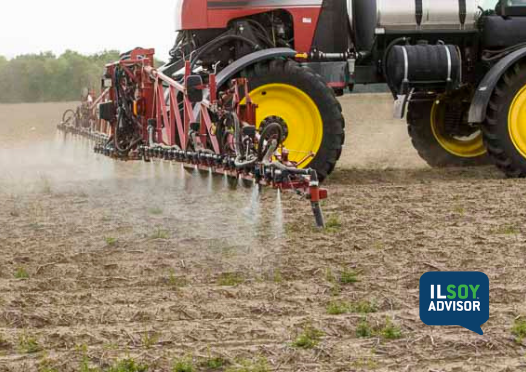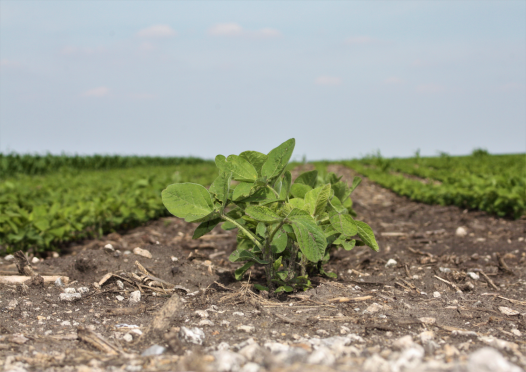ILSOYADVISOR POST
Weed Management: Weeds - The Word is "Change"
“The only thing that is constant is change,” wrote Heraclitus, a Greek philosopher who lived from 535 to 475 BC. While this is true for all of life, we can also say this about weeds! Actually, weed resistance management is about preventing or slowing the rate of change.
There are two issues to consider when looking at changes in weed populations: population shifts and the introduction of herbicide resistant weeds. Weed population shifts happen when new species become the dominant, driver weeds in the soybean management system. Herbicide resistance is a separate issue. We know that resistance can evolve rapidly in a population, by selecting for individual plants that already possess gene conferring resistance. The survival of these individuals leads to seed production, and a greater number of resistant individuals for the following year. In order to recognize population shifts and the development of herbicide resistant populations, you must have knowledge of the species present in your field to create a proper management plan and then monitor the success of management. Always pay attention to new weeds or changes in species dominance. Often 30% of a weed population has become resistant before we notice escapes. The key to a successful management program is catching these changes early.
Over the past 60 years of herbicide use, weed shifts have been documented. The first notable shift was after the introduction of 2,4-D, as there was a shift from broadleaf weed problems to grasses. In the 1960’s trifluralin (Think Treflan™) was labeled for postemergence use; trifluralin removed the grass competition and allowed prickly sida to become a problem.
In the 1990’s, glyphosate allowed growers to shift to no-till agriculture and small, wind-dispersed seeds like marestail found its perfect niche. With proper timing and application, our current soil residual herbicide programs are successful at controlling small seeded broadleaves—such as waterhemp—but we may see a resurgence of issues with large seeded broadleaf weeds, such as cocklebur and giant ragweed.
We have also seen a change in the identity of our driver weeds over time, with new species appearing. Waterhemp has had a presence in Illinois fields for a few decades, but now we see its cousin, Palmer amaranth, marching through Illinois from the south. Although Palmer amaranth is invading, it is possible that the same management tactics we use for waterhemp could slow its spread, compared to the speed at which waterhemp spread across the state.
So, how do these weeds arrive? We can probably pin most of the blame for long distance dispersal on the movement of machinery, as well as animals. Don’t minimize the importance of your own movement across your fields in spreading weed seeds. If possible, save the work in weedy fields for last, so you’re not spreading weed seeds to un-infested areas. Some weed seed movement is beyond our control; for example, the University of Missouri has completed a study looking at the long distance movement of Palmer seeds in the digestive tracts of birds. So even if you don’t think you have herbicide resistant weeds or Palmer amaranth in your field, adapting a proactive management plan can help prevent problems in the future.
We have to shift our thinking to management of the seedbank. We have to prevent weeds from emerging with a solid soil residual herbicide program with overlapping residuals, and we have to “start clean, stay clean” to slow the changes we see in the weed community.
Finally, I would like to leave you with a weed for which you’ll want to monitor your fields: Kochia (Kochia scoparia). Kochia is a driver weed out in the western Corn Belt and High Plains and is known to be present in some counties in Illinois. It has evolved resistance to four herbicide modes of action in the US and Canada: ALS inhibitors (chlorsulfuron and others), Photosystem II inhibitors (atrazine), synthetic auxins (dicamba), EPSP synthase inhibitors (glyphosate). For now, Kochia can be found along railroad rights-of-way and roadsides, but keep a lookout in your fields because its arrival may be inevitable.

Dr. Karla Gage is Assistant Professor of Weed Science and Plant Biology at Southern Illinois University Carbondale. She graduated from SIUC in 2013 with a Ph.D. in Plant Biology, focused in Weed Ecology. Dr. Gage’s research interests are: weed ecology, management, and evolution within managed and unmanaged systems; selection pressures leading to weed shifts and herbicide-resistance; integrated weed management systems and cover crops; and weed policy issues.




Comments
Add new comment